|
Related FAQs: Marine
Livestock Selection, and Reef
Livestock Selection & FAQs,
Marine Livestocking FAQs 1, FAQs 2,
FAQs
3, FAQs 4, FAQs 5,
FAQs 6, FAQs 7, FAQs
8, FAQs 9, FAQs 10, FAQs
11, FAQs 12, FAQs 13, FAQs
15, FAQs 16, FAQs 17, FAQs
18, FAQs 19, FAQs 20, FAQ
22, FAQs 23, FAQs 24, FAQs
25, FAQs 26, FAQs 27, Angelfish
Selection,
Related Articles: Avoiding Bad Choices: Saltwater Animals
That Are Commonly Offered in the Trade That Shouldn't Be, and
Suggested Alternatives, by Bob Fenner, Stocking,
/The Conscientious Reef Aquarist Series:
Organism Selection for the Saltwater
Aquarist, or
How to Go About Planning &
Picking Out Marine Livestock
With a Heavy Emphasis on Reef
Systems, pt. 2
Part 1, Part 3
|
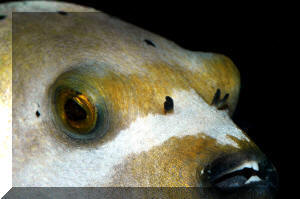
MD.JPG)
|
| Bob Fenner |
Puffers, need space, may well chew...
|
Toxic Life:
|
On the other hand, I still endorse the sale of venomous fishes
like the Scorpaenids (Lions,
Stonefish)( a Black Pterois volitans Lionfish at
right; below the Bearded Scorpionfish, Scorpaenopsis
barbatus; a Leaf fish, Taenionotus triacanthus), and
plotosid catfishes (Plotosus
lineatus),
|

|
|
And many Tangs (e.g. Naso
lituratus;), and their relatives, the Rabbitfishes (family Siganidae)( the Stellate
Rabbitfish, Siganus stellatus) are dangerously spiny AND
venomous if mishandled. Be careful when handling
these!).
|
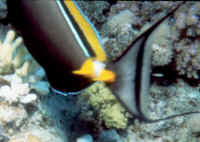
|

|
Though personally, I do wish the trade would stop carrying the
Blue-Ringed Octopus (Haplochalaena maculosa and others) and the
species of Cone Snails (Conus) that are deadly venomous to
unwary and unaware humans.
Selecting Good Specimens:
After determining which species of what's available are
compatible and desirable, what can you do to insure you're getting
the "pick of the litter" in choosing through them at your
dealers? Actually, quite a bit. Before launching into the particulars
of how to go about this I'd like to reinforce the notion of who
you, the consumer, is in this curious and crucial role. You're the
one "with the gold"; as in the Golden Rule. At least in this
version, you're the one who makes the rules. By casting your vote,
buying or not, you drive and direct financial markets; including
pet-fish ones. Don't ever forget this. You want value for your
money? Demand it with your dollars and your feet. Don't purchase
things, including life, from places you do not endorse; better still,
walk on out of them. Believe me; this is how bad situations are best
rectified.
Right Size: Mainly Wrasse Examples
For all species and specimens for you to consider there is a
"too small, too large, and right about the right range" of
sizes. Think of the Wrasses,
and know that their family name, Labridae is derived from the Greek
"labros", meaning "greedy". When little,
they're oh so cute, but many get to be big, some very quickly,
often by eating their tankmates. Here's an attractive juvenile
Napoleon or Humphead Wrasse ( Cheilinus
undulatus)(1) of about a foot length. Unfortunately it grows into a
monster of some 2.5 meters.
|
I remember working for a wholesaler of marines in California
in the sixties who complained that the Cuban Hogs (Bodianus
pulchellus) sent to us were too small (under two inches).
Sure enough, next shipment they came one to the box at about
¾ of a foot total length.
|
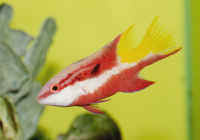 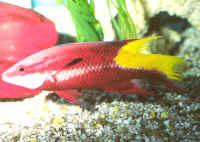 |
|
If you had to have a Hog in the genus
Bodianus, for your reef tank you'd be much better
off with a smaller member, such as Bodianus bimaculatus
(the Two-Spot at 9cm max.), or the Lyretail (Bodianus
anthioides).
|

|
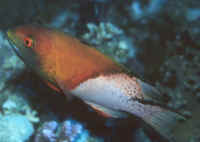
|
|
Or for folks who like a real challenge, the Leopard Wrasses (genus
Macropharyngodon)(shown male M. meleagris, the
Guinea Fowl Leopard Wrasse), or the sand-dwelling Pencil Wrasses
of the genus Pseudojuloides.(shown is a male P.
cerasinus). Among others, these stay relatively small,
don't hassle invertebrates and are both beautiful and
interesting behaviorally.
|
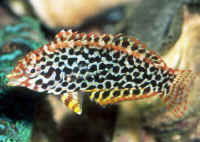 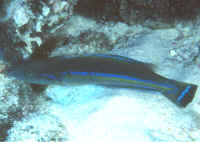
|
"Ideal" size for specimens to
be shipped 12/31/11
Hi Bob and Crew,
I'm ordering fish from Liveaquaria. Are medium specimens better
able to handle the stresses of shipping (more hardy) than small
specimens or is it about the same? For instance, their small Picasso
Triggers are 1" to 2" while their medium Picassos are 2"
to 3". Their small Papuan Toby Puffers are 1.5" to 2"
while their medium size is 2" to 3". Also, is there a
difference in hardiness of specimens from Sumatra or Indonesia?
Thanks,
Casey
<Good questions... There IS a definite difference in incidental
mortality per species, per size range... in the case of
Rhinecanthus triggers, the second range you mention is best... and
Canthigaster spp. the first range is better... Larger sizes of both
(and most all organisms) being worse...
Mmm, and your last query... Sumatra is part of Indonesia.
Bob Fenner>
Re:
"Ideal" size for specimens to be shipped
12/31/11
Haha, I must've missed the day they covered Indonesia....or most
geography, actually. Thanks for your quick reply.
<Welcome! Wish we were diving off the island right now!
BobF>
Too puny and too big individuals of even the "right"
species ship poorly and are much less likely to adapt to aquarium
conditions. Juveniles can't go as long without feeding, and this is
often a period of days to weeks from collection to the wholesaler that
feeds (many don't) or your dealers. Large individuals tend to be
"set in their ways" food and behavior-wise; what's more
they are much more expensive to ship (Transport is often the single
largest cost component of livestock dealing)
|
Series of Naso lituratus, too small (1
½"), too big (about a foot), and right in range 3
½-6".
|
Location/Source:
Irrespective of where you stand on "the cyanide
issue", whether it exists, how deleterious poison use is to the
intended catch, the environment, fisher-folk and their communities,
there is a direct correlation with "where" your livestock
originates and its likelihood of survival and longevity. Certainly
other factors are at least as important in contributing to loss of life
and vitality; time on hand at collectors,
"consolidators/shippers" to and through domestic-based
wholesale facilities; lack of feeding in most of this transit; stresses
of crowding, poor water quality; long airline hauling times; concurrent
chemical and physical insults from same... all add up to the fact that
livestock are better/best from closer, and more "controlled"
areas. In particular I must still generally vilify the
industry's two major country-sources, the Philippine Islands and
Indonesia as "B" sources of marines. Yes, there are a growing
number of conscientious businesses there, eschewing the use of
"economic poisons", but the other factors mentioned (airline
delays, long haul times, lack of feeding, "burn" from
overcrowding/too small a bag & water...) are still
damning.
|
Look around; there are MANY alternative catch sites, and new
ones every year, offering most of the key species at much better
net landed prices (when you count in mortality) than Indonesia or
the Philippines. Even if you don't believe you're
implicitly fueling reef destruction, over-fishing and continuing
impoverishment of indigenous peoples, the bottom line is the
bottom line; fishes and invertebrates are better from elsewhere.
( Indonesia shirts ala Mike Goddard).
|
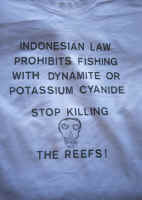
|

|
Captive bred or latter derived in the way of asexually
"reproduced" invertebrates (as in "fragmenting" SPS
corals). Are these a better choice than "wild caught" or
collected? Most of the times and in most ways, yes. This livestock is
better conditioned, or better put (with apologies to Darwin and
Wallace) "unnaturally selected", to put up with the vagaries
of human confinement. Already accepting of prepared foods and water
conditions, "man-made" or to-a-degree cultured stock in
general is much hardier than that coming fresh from the reef. In the
past, captive bred and reared fishes displayed a comparative loss of
color, genetic integrity and vigor opposed to their wild conspecifics.
Take a look now! They are much improved.
|
A batch of tank bred and reared Amphiprion clarkii and
Amphiprion ocellaris at right, captive made
Gobiosoma, captive bred and reared tridacnids at a
wholesaler's below
|

|
| Even marine algae are
being cultured in commercial numbers for the ornamental aquatics
trade: A wild shot of a brown algae, Dictyota, a
cultured green, Sea Lettuce, Ulva). |
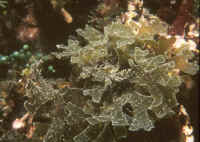
|
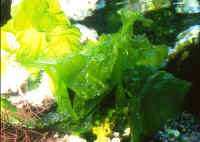
|
Obvious Signs of Damage & Disease:
|
Fish external parasites like
Ich (Cryptocaryon irritans) and
Velvet (Amylloodinium) are
easy to spot, either by their spotty/dusty appearance, and/or the
concurrent rapid breathing, hiding behavior they induce. Look
especially to the organisms eyes, fin origins, and mouth for
trouble signs ( a Kole, or Yellow-Eye Tang, Ctenochaetus strigosus, with an infected
mouth; this fish is more than likely doomed). Red or white sores,
swelling of any kind are a warning; the specimen may not be
necessarily infected, but its capacity to ward off disease is
impugned .
|
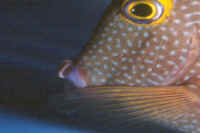 |
Both eyes should be clear and bright, neither sunken in or
bulging and not scratched. Minor scratches from rough handling often
solve themselves, but "pop-eye"
(exophthalmia), or sunken eyes may signal internal infection and
are serious matters that should disqualify a purchase. Depending on the
variety of fish in question, torn or frayed fins may not be a big deal;
infection is. Pay close attention for signs of infection at their
bases. Mouths and gill spines are often damaged in the process of
collecting and shipping. Look at enough clean, healthy specimens of the
species until you know how these are supposed to appear. (extreme
HLLE on a Koran Angelfish,
Pomacanthus semicirculatus, unilateral exophthalmia
(pop-eye) on a Chromileptis altivelis).
|
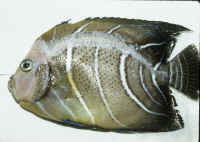
|
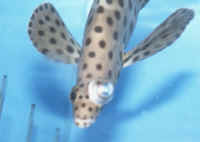
|
|
How about breathing rate and range of gill movement? And the
"fullness" of the body. What is the individuals
"index of fitness"; the ratio of diameter over length.
Is it overly "skinny", especially above the head? Along
the flanks? ( a thin & stout Yellow
Tail Blue, Paracanthurus hepatus). You want
well-fleshed specimens.
|
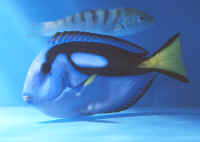 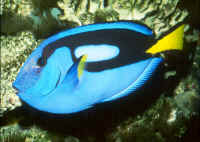 |
One way that fishes are different than the
more familiar companion animals (like dogs and cats and us) is how such
apparent poor physical condition can indicate a doomed individual. It
may not be dead yet, but soon will be; little to stop it.
Behavior: What to Look and Look Out For:
|
In many ways, behavior is the best measure of an organisms
vitality. Is the specimen out and about, curious about its
surroundings, interacting with its tankmates, responding to your
presence? ( a behaviorally well-adjusted Blue Face Angelfish,
Pomacanthus Euxiphipops xanthometopon; clamped-finned,
ataxic juvenile Imperator Angel; a great Pomacanthus
annularis and good-curious Chaetodonoplus). It should
be. Beware of spaced out, clamped-finned individuals, having
"private parties in the corners.
|
Jumping:
|
I wish I had a penny for every time someone is going to
say "El Nino" today, or for the marines that will
become "carpet jerky" by launching, crawling, otherwise
getting out of their system on a one-way trip to oblivion. Know
your livestock's' propensity for aquatic Houdiniism and
keep your tank covered, or water level low... About the only
non-jumpers/escape artists are the Seahorses and their kin. ( the Seahorse,
Hippocampus kuda; and a Yellow-Striped Pipefish,
Corythoichthys flavofasciatus). Really, just a note here
to keep your tank covered against such losses... fishes and
motile invertebrates.
|
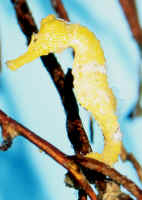 
|
Feeding:
Just because the you've located a "correct"
species, of the appropriate size and apparent good condition,
doesn't mean you should buy it. Is the specimen eating? Foods that
you intend to offer? Don't take someone's word on this; demand
that the stock be fed in your presence; at least once, better
twice.
Territoriality and Order of
Introduction:
| Like a Redox table displaying which chemical
"species" steals or loses electrons to which, a list can
be compiled of the most likely prevailing party in your systems
pecking order (an Undulated Trigger, Balistapus undulatus
near the top; a very docile Gobiodon would be near the
bottom). |
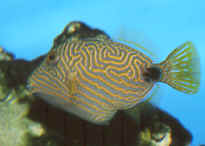 
|
|
Generally the largest (actual and ultimate) size
species/specimen wins; but not always (ounce for ounce, the true
terror of the reef, the Domino Damsel, Dascyllus
trimaculatus). The dynamics of who goes in, in what order,
sex ratios, best numbers of individuals (one, two, a few, many),
and habitat partitioning need to be worked out in advance of
purchase; best when planning out the size and components of the
system itself. ( a large Imperator
Angelfish. Pomacanthus imperator; the "king"
of its tank).
|
 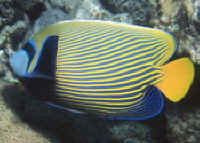
|
Remember, all marine life is
"aggressive" to a degree, and that there is a high degree of
variation in temperament within some species.
To: Part 1,
|
|

